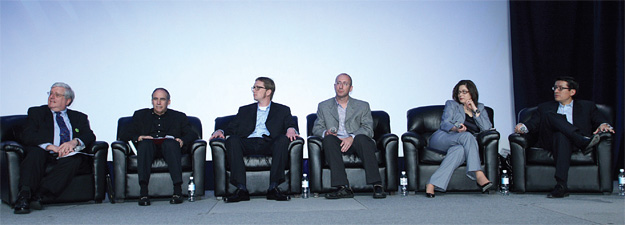Mobile DTV Gains Lie on the Horizon
"Ultimately what we're trying to do as broadcasters is reinvent television from 60 years ago," said Erik Moreno, senior vice president for corporate development at Fox Networks Group, speaking at the "Mobile TV: The Path to the Future" Super Session.
"Think about the cable business, which took 40 years to build, and we're doing it all in a very dynamic, very changing mobile landscape... we are trying to build a service that delights consumers."

Panelists discussed the future of the Mobile DTV business model.
As someone who is paid to predict the future, John Fletcher, an analyst with SNL Kagan looked at it this way: "We're cautiously optimistic... our overall overarching philosophy is that people love, humans love to watch other humans we love in motion pictures," he said. "It doesn't matter if it's big screen, home TV, desktop or mobile."
IF AT FIRST…
However, he noted that portable television has been commercially available since the 1960s. "Never really went anywhere, didn't catch on. Several panelists noted more recently the FLO mobile video venture failed, although they differentiated it from what they expect will be offered with Mobile DTV.
Mobile video has been rolled out in other countries already. "There is no unified technology around the world," said Ronen Jashek, vice president of marketing for Siano Mobile Silicon, which makes chips for Mobile DTV reception and display.
"Basically we have experience from various markets, where each of the markets have their own technology, their own business models, their own success stories. Some of them have failure stories." He cited Japan as a success story; Korea less so.
"The consumer increasingly is not one group," said Saul Berman, global strategy and change services leader at IBM Global Business Services. "There are different segments that will get their content in different ways; they will behave in different ways."
This means moving away from the traditional broadcasting approach of focusing on one large audience, Berman said, "because we're going to miss most of the new and developing audience if we do that. We'll find that some will want to pay, some want to have it advertising supported."
KEY PIECE OF THE PUZZLE
Berman reminded the group several times the importance of the business model. "A lot of what we're looking at is not only is the pie getting bigger or smaller, but who gets the money."
Randa Minkarah senior vice president of revenue and business development at Fisher Communications compared the quality video experience between individual streaming video over IP and one-to-many Mobile DTV.
As she was boarding her plane to Las Vegas, a fellow passenger lamented he could not watch The Masters. She had a Mobile DTV receiver with her. "I said, well hang on a second, and I was able to pull it up, and he was able to watch it. But if he'd tried to pull it down, and others on the plane tried to pull it down with cellular bandwidth, we'd have had a problem."
The elephant that everybody in the room talked about was whether cellular services would subsidize phones with Mobile DTV capability. The consensus was that enough other mobile DTV receiving devices were coming on the market that there would be viewers for the service.
The Kagan analyst closed with a bet: If in the next year one of the small regional carriers or one of the three big carriers doesn't offer a handset with ATSC-M/H, "I'm going to buy everyone in this room here a drink." © 2011 NAB
Get the TV Tech Newsletter
The professional video industry's #1 source for news, trends and product and tech information. Sign up below.
